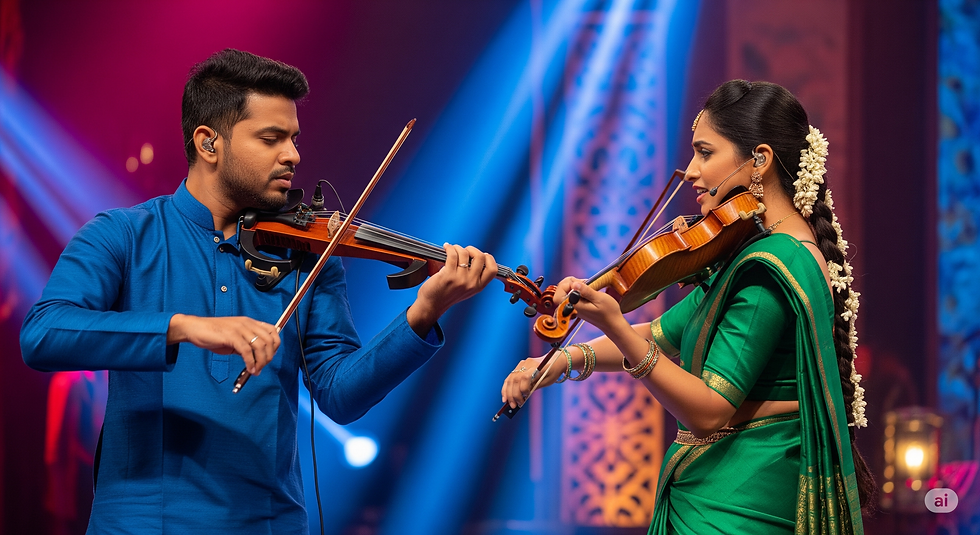Bows & Plucks: Your First Mohanam Geetham on Carnatic Violin & Veena
- Sharanya naidu
- Jun 16
- 3 min read
Updated: Jul 4
Namaskaram to all aspiring Carnatic musicians! Whether your fingers dance across the frets of the elegant Vara Veena or glide over the strings of the expressive Violin, the journey of learning Carnatic music is deeply rewarding. Today, let's dive into a foundational element of this rich tradition: the Geetham, and specifically, explore its beauty within the captivating raga Mohanam.

For those just beginning their Carnatic music exploration, the Geetham (literally "song") is a crucial stepping stone. Think of it as a simplified song form that lays the groundwork for more complex compositions like Swarajatis, Varnams, and Kritis. Geethams are typically short, melodically straightforward, and set in a specific raga (melodic mode) and tala (rhythmic cycle). They're excellent exercises to:
Introduce the Swaras (notes) of a Raga: Geethams are composed to showcase the characteristic phrases and movements within a given raga.
Develop Laya (Rhythmic Sense): The clear rhythmic framework of the tala helps learners internalize the beat.
Improve Pitch and Intonation: Understanding their vocal rendition is key for instrumentalists to grasp melodic nuances.
Build Foundational Technique: Repetitive phrases and clear structure allow instrumentalists to focus on bowing (Violin) and plucking/fretting (Vara Veena).
Now, let's immerse ourselves in the enchanting world of Raga Mohanam. One of the most beloved and frequently encountered ragas in Carnatic music, Mohanam exudes a bright, auspicious, and captivating aura. It's a Janya raga, meaning it's derived from a parent Melakarta raga (Kalyani). Mohanam distinguishes itself with its pentatonic (five-note) scale:
S R2 G3 P D2 S' (Sa Ri Ga Pa Dha Sa in solfège)
Notice the absence of Ma (Maadhyamam) and Ni (Nishaadham). This unique structure gives Mohanam its characteristic directness, melodic charm, and easy recognition. Its inherent sweetness makes it a favorite for both beginners and seasoned performers. Mohanam is often associated with feelings of joy, beauty, and devotion.
Experiencing the Geetham in Mohanam: Violin and Vara Veena Perspectives
Learning a Geetham in Mohanam on either the Carnatic Violin or the Vara Veena offers distinct yet complementary experiences:
On the Carnatic Violin:
The violin's smooth, continuous bow allows for seamless transitions between the swaras in Mohanam. The gamakas (graces and oscillations), characteristic of Carnatic music, are beautifully rendered, adding depth to the simple melodic lines.
Focus is placed on developing precise finger placement to accurately capture the shruti (pitch) of each swara. Even with its pentatonic nature, Mohanam demands careful attention to intonation to bring out its inherent beauty.
Bowing techniques, like smooth legato strokes and subtle pressure variations, contribute significantly to the Geetham's overall musicality, helping learners produce a clear and resonant tone.
Practicing Mohanam Geethams helps violinists smoothly navigate different positions on the fingerboard while maintaining the raga's characteristic flow.
On the Vara Veena:
The plucked nature of the Vara Veena produces a distinct, resonant tone for each swara. Learners focus on achieving a clear and consistent pluck with the right hand and precise fretting with the left hand for accurate pitch.
The Veena's longer sustain allows for a deeper appreciation of individual swaras. The meend (gliding) technique, crucial for Carnatic music, can be practiced effectively within a Mohanam Geetham, smoothly connecting notes and bringing out the raga's essence.
Understanding the tala becomes particularly important as rhythmic cycles are often emphasized through plucking patterns. This helps Veena players develop a strong rhythmic foundation.
Learning a Mohanam Geetham on the Vara Veena introduces students to the unique timbre and expressive capabilities of this majestic instrument within a familiar and accessible raga.
Why Start with a Mohanam Geetham?
Choosing a Geetham in Mohanam as an early learning piece is highly beneficial:
Accessible Raga: Mohanam's pentatonic scale is relatively easy for beginners to grasp and remember, with quickly recognizable characteristic phrases.
Melodic Simplicity: Geethams have simpler melodic structures, allowing learners to focus on fundamental techniques and raga understanding.
Ubiquity of Mohanam: You'll frequently encounter Mohanam in various Carnatic compositions, making a foundational understanding of this raga essential for further learning.
Aesthetic Appeal: Despite its simplicity, Mohanam is a beautiful and captivating raga, making the learning process enjoyable and inspiring.
In Conclusion
Learning a Geetham in Mohanam on either the Carnatic Violin or the Vara Veena is a significant and enjoyable step in your musical journey. It provides a solid foundation in raga identification, rhythmic awareness, and instrumental technique. As you gracefully bow your violin or pluck the resonant strings of your Vara Veena through the familiar phrases of Mohanam, you're not just playing notes; you're imbibing the essence of Carnatic music and connecting with a rich and timeless tradition.
Keep practicing, keep listening, and keep exploring the beautiful world of Carnatic music!



Comments